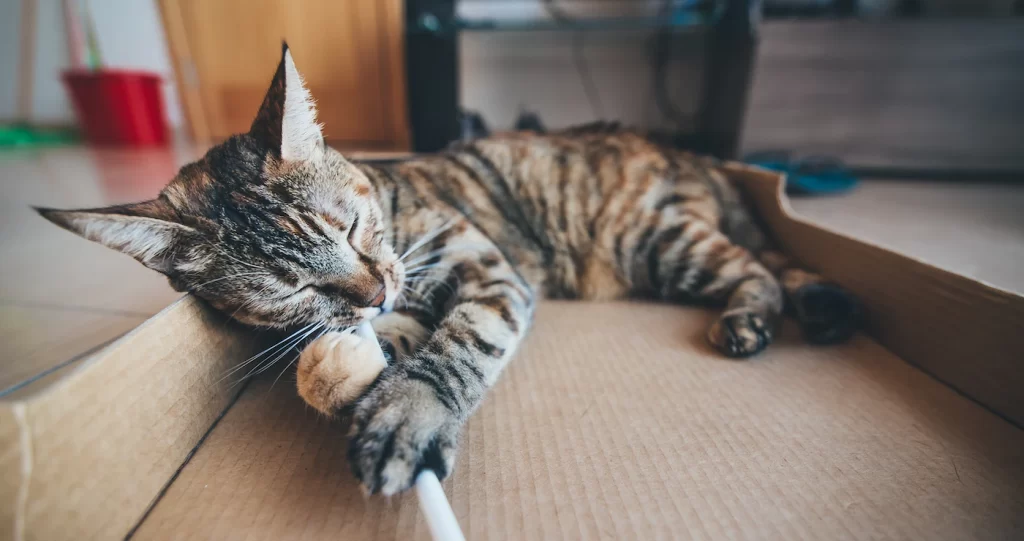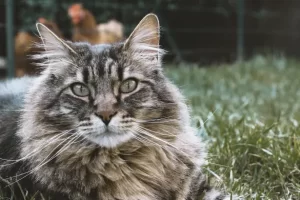Last updated on February 19th, 2023 at 04:09 am

Can cats eat ice cream? Ice cream is a popular treat that is liked by many people. It is normal to want to share a favorite meal with your cat, but this raises the question of whether it is acceptable to serve your cat a sample of ice cream. The short answer is no, not right now. It is not advised to give your cat ice cream as a reward. However, some cats can indulge in a small amount of ice cream without jeopardizing their overall health.
Ice cream should be avoided by cats for the same reasons that it should be avoided by humans: it is high in fat and sugar. Because of the high levels of sugar and fat included in ice cream, it should not be included in a feline’s diet. However, there are a number of other reasons to avoid eating ice cream, and these are more directly related to our feline companions.
Ice cream nutritional stats
The table below shows some nutritional information for half a scoop (65 grams) of plain vanilla ice cream. Keep in mind that different varieties of ice cream will have varying levels of certain nutrients, even though they are all high in fat and sweets. Although frozen yogurts and sorbets are lower in fat, they can still be heavy in sugar and include harmful chemicals.
| Calories (kcal) | 136 |
| Protein (g) | 2.3 |
| Fat (g) | 7.5 |
| Carbohydrate (g) | 15 |
| Fiber (g) | 0.4 |
| Sugar (g) | 14 |
| Sodium (mg) | 53 |
| Calcium (mg) | 84.5 |
| Phosphorus (mg) | 70 |
| Potassium (mg) | 131 |
At first glance, ice cream might not look like the worst choice, and you wouldn’t be wrong to think that it is. After all, it definitely has a lot of potassium, calcium, and phosphorus, which are all important minerals. Also, both vitamin A and vitamin D are in vanilla ice cream. Doesn’t that sound great?
Wait a minute before you go out and buy a bunch of your favorite flavor of ice cream, whether it’s cookies and cream, coconut mint, mint chocolate chip, or anything else.
Is ice cream safe for cats to eat?
Ice cream is not a treat that should ever be given to a cat for a variety of reasons. The first reason is that cats do not have a natural tolerance for lactose. Dairy goods, such as ice cream and frozen yogurt, can cause stomach cramps and discomfort, nausea, vomiting, diarrhea, and gas in cats because cats lack the enzymes necessary to effectively digest dairy products.
If your cat only takes one or two small licks of ice cream, you probably won’t notice any of these potentially dangerous effects. However, if you give your cat more than a few tastes of ice cream, you may start to see some digestive issues developing in your cat.
The nutrient profile of ice cream is another major factor that should convince you not to feed it to your cat for any reason. It contains a lot of sugar, fat, and calories all by itself. Due to the fact that cats are strict carnivores, they do not require any processed sugars in their diet. In moderation, consuming good fats is OK, however, the fats that are typically found in ice cream are considered “bad” fats and have little to no nutritional benefit.
Even though it’s true that kittens make a lot of the lactase enzyme in their bodies when they’re very young, they quickly outgrow this ability. As your cat gets ready to start eating solid food, she will need more enzymes to help her digest proteins.
It is important to keep in mind that healthy adult cats require approximately 20–35 calories per pound of body weight on a daily basis. This indicates that a typical 10-pound cat has a daily calorie need of just approximately 200–350 calories at most. When you consider that a serving of ice cream consisting of a half cup has approximately 125–150 calories, it is easy to see how the calories might mount up very rapidly for a cat. Below are deeper explanations of why you should not feed ice cream to your cats.
Cats are lactose intolerant
This means that cats don’t have enough lactase enzymes. This enzyme is needed to break down the lactose in milk. Keep in mind that some cats may have more of these enzymes than others. You could give her a little bit and see if she doesn’t like it. When your cat doesn’t need milk anymore, she will stop being able to digest it. On a good day, the lactose that hasn’t been broken down will only give her Hershey squirts. On a bad day, it will mix with all the other acids in her body and turn into a curd, which will hurt her a lot.
Ice cream can cause brain freeze in cats
Trying on purpose to make a cat’s brain freeze is a cruel thing to do. No matter how many views you get on YouTube, you shouldn’t do this. The term “brain freeze” refers to a condition in which the size of the anterior cerebral artery quickly changes when it is cold. This is an artery that brings blood to the brain.
Since there are no pain receptors in the brain, the pain signal could be coming from the meninges, which protect the brain. A cat’s nervous system is similar to a person’s, though it is smaller. Even though your cat won’t die from a brain freeze, it will make her feel bad.
Cats don’t like the cold
The truth is that cats have a higher body temperature than people do, so they get cold faster than people do. Kittens that are just born can’t even make their own body heat, so they could die from the cold. Even as adults, cats are drawn to the hottest spot in the house.
Is it okay for cats to eat chocolate ice cream?
Most animals, including cats, can’t live in the presence of theobromine, which is an alkaloid complex found in chocolate. Read the article “Can cats drink chocolate milk” to find out more about it. A lethal dose of theobromine for a cat is between 100 and 200 milligrams per kilogram of body weight. Even a small amount of chocolate ice cream could be dangerous for a cat since just one ounce of cocoa powder can have as much as 800 milligrams of theobromine.
Can cats eat vanilla ice cream?
If your cat has to have ice cream, vanilla might be the best flavor for him or her. If you want to give your cat ice cream without worrying about him leaving a particularly smelly litter box, goat’s milk ice cream is a good choice. Goat’s milk does not require pasteurization. This means that some of the enzymes that are found in nature are still in the fluid. In fact, some of these enzymes help break down lactose. If you make it yourself, just cut back on how much sugar you use.
Do cats get sick when they eat ice cream?
In reality, giving your cat ice cream won’t kill it, but it also won’t make it healthier. Most cats can’t handle lactose, so they usually don’t eat milk or products made from milk. If you don’t remember this information and give your cat something that has milk in it, he may have trouble digesting it. If your cat likes ice cream, remember that you can make it at home with goat’s milk instead of cow’s milk and an ice cream maker.
Is It Possible For Ice Cream To Make A Cat Throw Up?
There is a potential that eating ice cream will cause your cat to throw up. Because of the significant amount of sugar that is found in ice cream, you should not feed it to your cat. Amylase is an enzyme that assists in the digestion of carbohydrates and large sugar levels; however, cats are unable to manufacture this enzyme on their own. Because they are unable to digest sugar, eating it can cause severe digestive issues, which might ultimately result in vomiting.
How Much Ice Cream Is Safe For A Cat To Consume?
It is in your best interest to completely abstain from ice cream. This isn’t simply due to the fact that ice cream has both sugar and fat in it. There is a possibility that chocolate ice cream is dangerous, and peanut butter ice cream may include xylitol, a sweetener that is known to be harmful. If you are certain that your ice cream does not contain any harmful chemicals and you are set on giving your cat a taste, you should only give them a very small amount.
Ice cream may cause digestive issues in cats due to their inability to digest lactose, and the high-fat content may lead to inflammation of the pancreas. You shouldn’t give the cat more than one or two licks, and even that could be too much for a hypersensitive cat to handle.
How Frequently Is It Okay For A Cat To Eat Ice Cream?
Ice cream is not a necessity for cats. Even though it might appear to be a rare and delicious treat, you should generally avoid giving it to your cat because there is a chance that it could give him diarrhea. However, if you are certain that you want to provide ice cream, you should only provide simple vanilla ice cream and check to be sure that it does not include any potentially harmful artificial sweeteners such as xylitol. In an ideal world, you wouldn’t make it available too often—just once in a while, or even less frequently!
Conclusion
No matter what kind of food you give your cat, at least 90% of its diet should be high-quality food made just for cats. Your cat’s diet should be based on how old it is, since young cats, adult cats, and older cats all have different nutritional needs. Food for kittens, food for adult cats, and food for older cats should all be avoided.
Because treats quickly add up to a lot of calories, you should never give them in large amounts. Most of a cat’s weight gain and obesity are caused by how many treats it eats. It’s important to keep your cat’s weight at a healthy level because overweight cats are much more likely to get diseases like diabetes and heart disease. If you are worried about your cat’s weight and don’t know if it is healthy or not, talk to your cat’s vet. They will be able to tell you if your cat’s weight is healthy and what you can do to help it lose weight in a healthy way. They will also be able to tell you if your cat needs to lose weight or not.
If your cat loves ice cream, giving it a tiny bit of the frozen treat every now and then shouldn’t be a problem. Ice cream, on the other hand, could make your cat fat and give them stomach problems if you give them a lot of it or give it to them often as a treat. Because there are so many other tasty treats for cats, it is recommended that ice cream not be used as a reward. However, ice cream can be given to cats on occasion without putting them at risk as long as the right amount is given.


